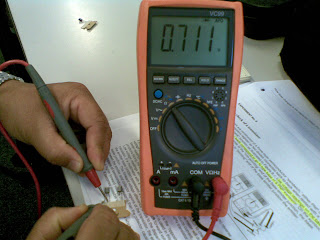Caculation for R14 &R15:
R = Vs - VLed - Vce / Ic ( R = 12Vs - 1.80V Led - 0.2Vce / 0.02A Ic= 500 ohms
R14 & R 15 = 500 ohms.
Ib = from data sheet ( Ic = 10mA =0.5mA)
Ic = 20 mA , Ib = 1mA (sat)
B = 110 from the data sheet
Ib = Ic / B 0.02A/ 110 = Ib 0.00018A
R13, 16 = Vb - Vbe / Ib ( 5V - 0.7V / 0.00018A = 2388 ohms (2.4K ohms)
R13,16 = 2.4 K ohms
The current Ib is low and high risistor in this stage transistor is not saturated , lets find other risistor for Rb.
Vbe (sat) Ic = 10mA , Ib = 0.5mA or Ic = 100mA , Ib= 5mA ( from data sheet)
Ic = 20mA , Ib = 5mA (from data sheet)
Rb13,16 = Vb - Vbe / Ib ( 5V - 0.7V / 0.005 = 860 ohms
Rb 13 & 16 = 860 ohms
Saturation: Rb = 5V- 0.7V / 0.005A= 860 ohms
Active ( current gain ); Ib = Ic / B
Rc = Vcc - Vled - vce / Ic ( 12v - 1.8 v - 0.2v / 0.002A = 500 ohms)
Summary;
Vs = 12V
Led= 1.8V
Vce= 0.2V
Ic = 20mA
R14, 15 = 500 ohms
Vb = 5V
Ib = 5mA
Rb 13, 16 = 860 ohms
Vbe = 0.7V
Next step start to disigened the circuit on Loc Master 03
I have start to build the circuit;
Componint : two C577 transistor, two 1.8v LEDs, two 1Kohms risistors, two 680 ohms risstors & circuit bord.
This is a bipolar junction transitor circuit consist of two LEDs in parallel, four roistors, and two transistors which i will be focusing on there functions. BJT has three terminal electronic divice constracted of dope semiconductor materialwhich is using in switching applications.
This BJT circuit needs only 5V to switch a 20mA lamp it means that this 5V Will go trogh base to emitter to open the gates for Vcewich is higher voltage to cause the signal or the LED to flash and this process take place in Active Region of the transistor, Normally transistor has three regions.
1) Active Region; where power dissipation is very high.
2) Satuaration Region ; with both junction forward biase, BJT saturation mode facilites high current conduction from emetter to the collecor which is closed switch.
3) Cut off Region: This is the opposiite to saturation , both junction are revers bias there is very little current flow which corresponds to an open switch.
The easy and more effecint way to find the three region and calculate the current gain is the graph of Vce, Vs , Ic for diffrent level of Ib and the common emetter circuit B (Beta) which is ratio between collector current and base current and represinting in B = Ic / Ib
The two pulsing terminal which are only 5V going throgh base to emitter (Vbe) and this will open the gate for the collector to emitter (Vce) .
TEST:
Test
Suppling 12V to the circiut with two terminals connected to the 5V supplay for the open gates of the VCE.
Checked avaliable voltage in varios points and the ressults were positive, checked available voltage after R15= 11.38V, voltage drope led 2 2V , voltage drope vce 0.74v, voltage drope bce 0.72v , voltage drope between R15 to colector 6.20V, LED1 voltage drope 1.90V, transistor2 be 0.70V.
testing of this circiut gave me positve result because switching the transistor voltage 0.6v - 0.70V and the Led s on ad brightness . i can say if the vbe is less the the current cant flow to emmiter and the LEDs of this circuit shuld not brightt,.
Reflection:
I made this circuit sample and easey i follow the instruction and also i had no diffeculty in this circuit just only i had connect one of resistor in wrong place than i noticed quuik unsoldred and put on right place .
next time i hope i would make batter than this circuit.

















































